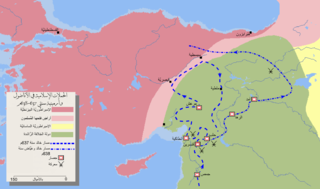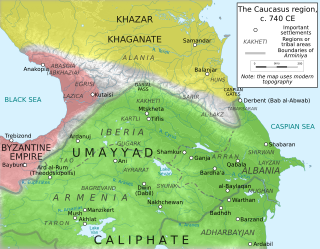Related Research Articles

Caucasian Albania is a modern exonym for a former state located in ancient times in the Caucasus: mostly in what is now Azerbaijan. The modern endonyms for the area are Aghwank and Aluank, among the Udi people, who regard themselves as descended from the inhabitants of Caucasian Albania. However, its original endonym is unknown.

In Greco-Roman geography, Iberia was an exonym for the Georgian kingdom of Kartli, known after its core province, which during Classical Antiquity and the Early Middle Ages was a significant monarchy in the Caucasus, either as an independent state or as a dependent of larger empires, notably the Sassanid and Roman empires. Iberia, centered on present-day Eastern Georgia, was bordered by Colchis in the west, Caucasian Albania in the east and Armenia in the south.

The Muslim conquest of Persia, also known as the Arab conquest of Iran, was carried out by the Rashidun Caliphate from 633 to 654 AD and led to the fall of the Sassanid Empire as well as the eventual decline of the Zoroastrian religion.

Zoroastrians are the oldest remaining religious community in Iran. Prior to the Muslim conquest of Iran, Zoroastrianism was the primary religion of the Sassanid Iran.

The Emirs of Tbilisi ruled over the parts of today's eastern Georgia from their base in the city of Tbilisi, from 736 to 1080. Established by the Arabs during their invasions of Georgian lands, the emirate was an important outpost of the Muslim rule in the Caucasus until recaptured by the Georgians under King David IV in 1122. Since then, the city has served as the capital of Georgia.

Javanshir, was the prince of Caucasian Albania from 637 to 680, hailing from the region of Gardman. His life and deeds were the subject of legends that were recorded in Armenian medieval texts. He was from the Parthian Mihranid family, an offshoot of the House of Mihran, one of the seven Parthian clans of the Sasanian Empire.

Barda is a city and the capital of the Barda District in Azerbaijan, located south of Yevlax and on the left bank of the Tartar river. It served as the capital of Caucasian Albania by the end of the 5th-century. Barda became the chief city of the Islamic province of Arran, the classical Caucasian Albania, remaining so until the tenth century.

Umar was the second Rashidun Caliph and reigned during 634–644. Umar's caliphate is notable for its vast conquests, aided by brilliant field commanders, he was able to incorporate present day Iraq, Iran, Azerbaijan, Armenia, Georgia, Syria, Jordan, Palestine, Lebanon, Egypt, and part of Afghanistan, Turkmenistan and south western Pakistan into the Caliphate. During his reign, the Byzantines lost more than three fourths of their territory and in Persia, the Sassanid Empire ceased to exist.

The Muslim conquest of parts of Armenia and Anatolia was a part of the Muslim conquests after the death of the Islamic prophet Muhammad in 632 CE.

Arminiya, also known as the Ostikanate of Arminiya or the Emirate of Armenia, was a political and geographic designation given by the Muslim Arabs to the lands of Greater Armenia, Caucasian Iberia, and Caucasian Albania, following their conquest of these regions in the 7th century. Though the caliphs initially permitted an Armenian prince to represent the province of Arminiya in exchange for tribute and the Armenians' loyalty during times of war, Caliph Abd al-Malik ibn Marwan introduced direct Arab rule of the region, headed by an ostikan with his capital in Dvin. According to the historian Stephen H. Rapp in the third edition of the Encyclopedia of Islam:
Early Arabs followed Sāsānian, Parthian Arsacid, and ultimately Achaemenid practice by organising most of southern Caucasia into a large regional zone called Armīniya.
Medieval Armenia refers to the history of Armenia during the Middle Ages. It follows Ancient Armenia and covers a period of approximately eight centuries, beginning with the Muslim conquest of Armenia in the 7th century. Key events during this period includes the rebirth of an Armenian Kingdom under the Bagratid Dynasty, followed by the arrival of the Seljuk Turks. During this period, a portion of the Armenian people migrate to Cilicia to seek refuge from invasions, while the remnants in Eastern Armenia see the establishment of Zakarid Armenia under the Kingdom of Georgia. This period also marks the emergence of the royal dynasty in Artsakh.

Foreign relations exist between Armenia and Georgia. Both countries are former Soviet republics of the Soviet Union. Both countries' governments have had generally-positive relations, but there have also been some problems.

Principality of Iberia was an early medieval aristocratic regime in a core Georgian region of Kartli, i.e. Iberia per classical authors. It flourished in the period of interregnum between the sixth and ninth centuries, when the leading political authority was exercised by a succession of princes. The principate was established shortly after the Sassanid suppression of the local royal Chosroid dynasty, around 580; it lasted until 888, when the kingship was restored by a member of the Bagrationi Dynasty. Its borders fluctuated greatly as the presiding princes of Iberia confronted the Persians, Byzantines, Khazars, Arabs, and the neighboring Caucasian rulers throughout this period.
The Church of Albania or the Albanian Apostolic Church was an ancient, briefly autocephalous church established in the 5th century. In 705, It fell under the religious jurisdiction of the Armenian Apostolic Church as the Catholicosate of Aghvank centered in Caucasian Albania, a region spanning present-day northern Azerbaijan and southern Dagestan.

Islam in Georgia was introduced in 654 when an army sent by the Third Caliph of Islam, Uthman, conquered Eastern Georgia and established Muslim rule in Tbilisi. Currently, Muslims constitute approximately 9.9% of the Georgian population. According to other sources, Muslims constitute 10-11% of Georgia's population.

Arab rule in Georgia refers to the period in the History of Georgia when all or part of the country was under political domination of Muslim Arab rulers, from the first Arab incursions in the mid-7th century until the final defeat of the Emirate of Tbilisi at the hands of King David IV in 1122. This period is called Araboba (არაბობა) in Georgian. Compared with other regions which endured Muslim conquests, Georgia's culture, and even political structure was not much affected by the Arab presence, as the people kept their faith, the nobles their fiefdoms, and the foreign rulers mostly insisted on the payment of tribute, which they could not always enforce. Still, repeated invasions and military campaigns by the Arabs devastated Georgia on many occasions, and the Caliphs retained suzerainty over large parts of the country and exerted influence over the internal power dynamics during most of the period.

The Dabuyid or Gaubarid Dynasty was a Zoroastrian Iranian dynasty that started in the first half of the seventh century as an independent group of rulers, reigning over Tabaristan and parts of western Khorasan. Dabuyid rule over Tabaristan and Khorasan lasted from ca. AD 642 to the Abbasid conquest in 760.

The Sassanid Empire or Sassanian Dynasty is the name used for the Persian dynasty which lasted from 224 to 651 AD.
In the history of Azerbaijan, the Early Middle Ages lasted from the 3rd to the 11th century. This period in the territories of today's Azerbaijan Republic began with the incorporation of these territories into the Sasanian Persian Empire in the 3rd century AD. Feudalism took shape in Azerbaijan in the Early Middle Ages. The territories of Caucasian Albania became an arena of wars between the Byzantine Empire and the Sassanid Empire. After the Sassanid Empire was felled by the Arab Caliphate, Albania also weakened and was overthrown in 705 AD by the Abbasid Caliphate under the name of Arran. As the control of the Arab Caliphate over the Caucasus region weakened, independent states began to emerge in the territory of Azerbaijan.
References
- ↑ Chaumont, M. L. "Albania". Encyclopædia Iranica. Archived from the original on 2007-03-10.
- ↑ Ronald Grigor Suny (1994). The Making of the Georgian Nation. Indiana University Press. pp. 26–27. ISBN 978-0-253-20915-3 . Retrieved 8 May 2012.